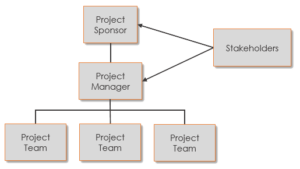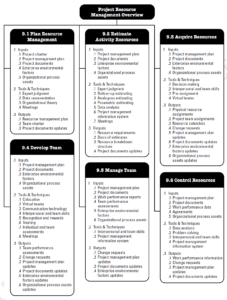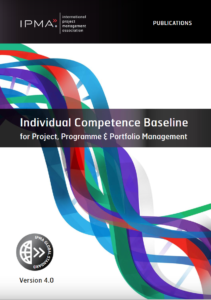
In project management, the project team is the component of the project organizational chart that carries out the project’s technical work.
The project team reports to the project manager.
For small projects, the project team and the project manager can be the same person. But this does not invalidate the presence of the separate roles.
The main project roles are:
- the project sponsor is one level above the project manager. They usually manage the project funding and accept its deliverables.
- the project manager is the highest level of authority and accountability within the project, who produces the project management plan and ensures the deliverables are produced according to the plan. They ensure the project completes on time, on budget, and that all stakeholders are satisfied. In short, they are accountable for project success.
- the project team carries out the day to day technical work of the project. They produce the project’s deliverables. They are responsible for carrying out the tasks that are assigned to them and report to the project manager.
- the project stakeholders have varying interests in the project and exert their influence as necessary to meet their personal or organizational goals.
 In the agile framework, a slight change is made. Customers and end users (a type of stakeholder) interact directly with the project team, who are empowered to make decisions with budget and schedule implications based on stakeholder’s needs. This allows product changes to be implemented rapidly without layers of management approval, hence the term agile.
In the agile framework, a slight change is made. Customers and end users (a type of stakeholder) interact directly with the project team, who are empowered to make decisions with budget and schedule implications based on stakeholder’s needs. This allows product changes to be implemented rapidly without layers of management approval, hence the term agile.
Project Teams in the Project Management Body of Knowledge
In the 6th edition of the Project Management Body of Knowledge (PMBOK Guide), the project human resources management knowledge area has been re-branded simply project resource management, thereby encompassing the broader category which includes physical resources such as materials and equipment. Hence, project teams are considered one of several types of project resources.
There is no prescribed generic project organizational chart within the PMBOK Guide, although the above four roles are well defined within it. For example,
PMBOK Guide, 6th Edition, 9.1.3.1
The project organization chart for a 3,000-person disaster response team will have greater detail than a project organizational chart for an internal, 20-person project.
The Project Resource Management knowledge area contains six processes which govern the management of project teams:

- Plan Resource Management
During this initial planning stage, a resource management plan is created which outlines what the roles and responsibilities will be, how the team will be acquired, and any constraints and assumptions. In addition, a team charter specifies the team values, communication guidelines, conflict resolution processes, and so forth. - Estimate Activity Resources
Also in the planning phase, the human resources must be estimated and allocated to each project task, to determine the amount of hours, days, or months of labor are required to carry out the project. - Acquire Resources
Once the project is underway, the project team must be acquired. This process includes the activities involved in hiring the project team, including advertising, interviewing, and hiring. - Develop Team
This process is specific to the project team rather than other physical resources. Since projects are temporary endeavors with a definitive beginning and end, most project team members must know that they are leaving the project with more than they started with, in order to stay motivated. This could be additional knowledge and skills, or it could be a better chance at a future project (reference). Also, performance evaluations are performed to maximize the return on the project team. - Manage Team
The project team must be actively managed to ensure they perform the project work on time, on budget, meeting the required quality levels, and any other project success criteria. - Control Resources
During the project control activities, the project team must be assessed by the project manager to ensure they are still meeting the needs of the project and fulfilling the project plan. If not, the team must change to meet the project management plan, or the project management plan must change to meet the existing project team.
Project Teams in PRINCE2
 Since PRINCE2 is more of a project organizational system than a general project management knowledge base like the PMBOK Guide, the project organizational structure is very well defined.
Since PRINCE2 is more of a project organizational system than a general project management knowledge base like the PMBOK Guide, the project organizational structure is very well defined.
The second of seven PRINCE2 themes, called Organization, defines the structure of a PRINCE2 project. Some of the roles may be combined into one person but each separate role is still present.
The project team is separated into two parts:
- The Team Manager is responsible for ensuring production of the products allocated by the project manager. They represent the day to day task prioritization for the project team.
- The Project Team carries out the day to day project technical work.
In addition, several other roles interact with these two:
- The Project Manager delegates responsibility for the managing product delivery process to the team managers. Hence, the project manager role is more of an oversight one than one of direct day to day involvement in the production of deliverables.
- Project Support provides administrative support or advice and guidance on the use of project management tools to both the project manager and project team. Often, an organizational project office is available which fulfills this role.
Project Teams in the IPMA Individual Competence Baseline
 In the Individual Competence Baseline produced by the International Project Management Association (IPMA), the primary section governing project teams is People 6: Teamwork. In this competence element, the standard for project managers is defined based on their ability to select the right team members, promote a team orientation and effectively manage the project team.
In the Individual Competence Baseline produced by the International Project Management Association (IPMA), the primary section governing project teams is People 6: Teamwork. In this competence element, the standard for project managers is defined based on their ability to select the right team members, promote a team orientation and effectively manage the project team.
There are five key competence indicators:
- Select and build the team
- Promote cooperation and networking between team members
- Support, facilitate, and review the development of the team and its members
- Empower teams by delegating tasks and responsibilities
- Recognize errors to facilitate learning from mistakes






